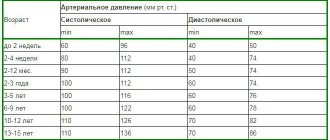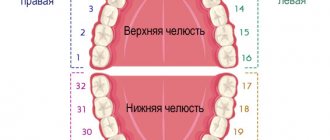How is heat distributed in the body?
Heat is generated in all internal organs and tissues. However, it is not distributed evenly. Thus, the highest temperature is observed in the muscles, kidneys and liver. Minimal heat generation occurs in the skeletal system and tendons.
Skin and muscle tissue generate more heat than internal organs. The thermal core is considered to be the liver, brain and heart. Depending on the specific area, the temperature in them can reach up to 38 0C.
The temperature on the skin will also differ, depending on the distance of a certain area of the skin from the thermal core. Indicators can vary from 29.5 to 36.9 0C.
First aid for overheating and cooling
When providing first aid as a result of “overheating” when heat or sunstroke occurs, the person is transferred to a ventilated and cool place where he will be protected from sunlight. The victim's clothes are removed, washed with cold water and a cold compress is applied to the forehead. Be sure to try to give them cool water or tea.
In case of hypothermia, it is necessary to warm the victim as quickly as possible. To do this, they bring a person into a warm room or car, remove his wet or cold clothes, begin to rub him with a warm soft cloth (gloves or hats are used as auxiliary material), and wrap him in a blanket. Gloves are put on the victim's hands and woolen socks on his feet. They also try to give them hot sweet tea.
Important! In both cases, it is necessary to call an ambulance, since the patient’s condition may be more unstable than it seems at first glance, and can lead to the death of the person.
Normal adult body temperature by age
Body temperature can vary not only depending on age, but also other factors - time of day, body area, physical activity, food intake.
| Age | Standards (0C) |
| Newborns up to 1 year | 37-38 |
| Children under 5 years old | 36,6-37,5 |
| Adolescence | 35,5-37,8 |
| Adults from 18 to 65 | 36-37,4 |
| Elderly people over 65 years of age | 36,3 |
In the age range from 18 to 65 years, indicators can vary in a clinically insignificant range.
Basal
Basal (rectal) temperature is measured immediately after sleep.
Indicators:
- Infants under 2 years old – 36.6-38 0C.
- Children from 3 to 10 years old – 36.6-38 0C.
- Children from 11 and adults up to 65 years old – 37.0-38.1 0C.
- Over 65 years – 36.2-37.3 0C.
Most often, this measurement method is used in women before ovulation or when planning pregnancy.
Armpit
Body temperature in the armpit is measured quite often and can vary within 3 degrees depending on age.
Thus, the following standards have been adopted:
- Newborns and children under 2 years old – 34.7-37.3 0C.
- Children from 3 to 10 years old – 35.9-36.7 0C.
- From 11 to 65 years – 35.2-36.9 0C.
- Over 65 years old – 35.6-36.3 0C.
In older people, a slight increase in temperature may indicate severe fever.
In the mouth
The temperature in the oral cavity also depends on the person’s age and can change throughout the day.
Standards:
- Newborns up to 2 years old – 35.5-37.5 0C.
- Children from 3 to 10 years old – 35.5-37.5 0C.
- From 11 to 65 years – 36.4-37.6.
- Elderly patients over 65 years old – 35.8-36.9
Normal body temperature for an adult
This measurement method is often used in pediatric practice, since other methods are difficult to perform at this age.
In the ear
The normal body temperature in an adult in the ear also differs from the indicators when measuring temperature at other points.
For newborns under 2 years of age, the norm is considered to be from 36.4 to 38 0C. For children under 11 years of age, this indicator will vary from 36.1 to 37.8 0C. For children from 11 years of age, as well as in adults up to 65 years of age, normal values are from 35.9 to 37.6 0C. In people over 65 years of age, the temperature varies from 35.8 to 37.5 0C.
In the groin fold
This method of measurement is indicated for children over 5 years of age. Normal values for all ages are considered to be a temperature from 36.3 to 36.9 0C.
In the elbow bend
This method is most often used in women during breastfeeding. The normal value is a temperature of up to 37.5 0C. The age of the patients is not taken into account.
When should you start taking action?
If the temperature drops by 1-2 degrees from normal, you should consult a doctor.
Especially if the condition lasts 1-3 days; At a temperature of 38-39°C, which is often observed during viral diseases and infections, the temperature should be lowered at home. For children, it is recommended to take an antipyretic drug at temperatures of 38°C and above. Adults - at 38.5°C;
If the temperature rises to 40°C and does not decrease with ibuprofen, panadol, mefenamic acid, you should call an ambulance. This is especially true for children.
Why can normal body temperature change with age?
As people age, thermoregulation, which is responsible for body temperature, changes. To determine the norm for each elderly person, it is necessary to take daily temperature measurements for 1-1.5 weeks.
With age, the sensitivity of thermoreceptors that respond to changes in temperature, both their own and the environment, also changes. An important factor is the slowdown of metabolism, which also affects the thermoregulation system.
Temperature changes in some cases may be associated with the presence of diseases characteristic of older people - diabetes, atherosclerosis, heart attack.
Temperature that does not need to be reduced
The fever itself is not dangerous, and if the body temperature does not exceed 38.50 C, you can not bring it down1. Another question is that this worsens overall well-being. Along with the temperature (and sometimes regardless of it), a feeling of weakness, weakness, unmotivated fatigue, drowsiness, headache and muscle aches appear3. The picture is complemented by the symptoms of ARVI: runny nose, nasal congestion, sneezing, sore and sore throat, cough and other signs of respiratory tract damage. The main emphasis should be on combating these manifestations of the disease. Complex medications, such as TheraFlu for colds and flu, help reduce the severity of symptoms4. Thanks to the combination of several active components, TheraFlu fights headaches, body aches, nasal congestion, sneezing and other manifestations of ARVI5, regardless of whether the body temperature is elevated4.
In what cases does low and high temperature indicate the norm for an adult?
Changes in temperature indicators are not always a pathology. In some cases, decreases and increases in temperature may be associated with natural physiological changes.
What is considered normal:
- hormonal changes in the body in women (pregnancy, menstruation, ovulation, lactation);
- taking certain medications;
- congenital features of physiology;
- climate change (acclimatization);
- consumption of hot or cold drinks, dishes;
- systematic physical activity;
- carrying out surgical interventions.
These conditions do not require therapy, but should be monitored by a specialist. In most cases, the symptom goes away on its own within a day. With acclimatization, the condition may persist for several weeks.
Fluctuations in temperature due to influenza
After the first clinical symptoms appear, patients note that the fever lasts up to 4-5 days. While taking medications, the temperature drops to low-grade levels, without reaching normal values. Episodes of relative increase are associated with further spread of the virus. The death of epithelial cells of the respiratory tract leads to the formation of foci of necrosis - this is how the protective barrier is destroyed.
In addition, influenza suppresses the immune system, reducing the number of white blood cells. Damaged epithelium and weak local protection create favorable conditions for the massive proliferation of opportunistic flora - a secondary bacterial infection occurs. Infectious agents such as:
- Haemophilus influenzae (or Haemophilus influenzae);
- Staphylococcus aureus (or Staphylococcus aureus);
- Streptococcus pneumoniae (or Streptococcus pneumoniae).
Therefore, microbial pneumonia is considered the most common complication of influenza. It should be considered if the patient's fever lasts longer than 5 days. Sometimes bacterial pneumonia develops earlier - 3-4 days from the onset of the disease.
It is indicated by a specific change in the temperature curve: after a short period of normalization (without the help of drugs), the patient begins to have a fever again. Therapists warn zealous workaholics about this development of events. If these patients with untreated flu strive to bring down the temperature as soon as possible and “get back to work,” they risk ending up in a hospital bed with pneumonia, pleurisy and losing their health or life.
How to measure temperature correctly?
The normal body temperature for an adult may vary depending on age, the measurement technique used and the correctness of the procedure. Therefore, it is necessary to strictly adhere to the prescribed rules.
Temperature can be measured using various methods and thermometers. For this purpose, mercury, alcohol or electronic thermometers are used.
When using an electronic thermometer, hold it until the beep stops. As a rule, most patients take out the thermometer from the first seconds of the sound signal, which is incorrect and leads to errors in the results.
When measuring the temperature in the armpit, it is necessary to wipe it with dry tissue and firmly hold the thermometer in the recess. It is recommended to keep the device for at least 5-10 minutes. In this case, the indicators will be more accurate.
Before measuring, you should adhere to the following rules:
- avoid physical activity and other stress;
- stop smoking;
- avoid drinking hot drinks;
- stop taking medications (especially antipyretics);
- do not use hot baths.
To measure the temperature in your mouth, place the thermometer under your tongue and close your mouth tightly. When taking rectal measurements, it is recommended to use plastic electronic thermometers, since glass devices often lead to injury (especially in infants).
Causes of high temperature
Reasons that cause high fever include:
- viral and bacterial infections (ARVI, influenza, tonsillitis, measles, rubella, mumps, chicken pox, mononucleosis, bronchitis, pneumonia, tuberculosis, COVID-19, epiglottitis, gastroenteritis, acute otitis media, acute external otitis, acute rhinosinusitis, urinary infections pathways, hepatitis, meningitis, encephalitis and many others);
- overheating (heatstroke);
- medications (some antibiotics, antihypertensives, anticonvulsants);
- autoimmune and inflammatory diseases (rheumatoid arthritis, systemic lupus erythematosus, ulcerative colitis, Crohn's disease);
- oncological diseases (Hodgkin's lymphoma, non-Hodgkin's lymphoma, leukemia);
- appendicitis;
- abscess;
- thrombophlebitis;
- reaction to the introduction of vaccines;
- high physical or emotional stress.
In some cases, the cause of the high temperature cannot be determined. If the fever persists for more than 3 weeks, and diagnostic tests do not clarify the picture, a diagnosis of fever of unknown origin is made.
A special symptom rating scale from the American Academy of Family Physicians will help determine the possible causes of a high temperature (while you are waiting for medical help).
Fever in adults
In an adult, an increase in temperature can occur for various reasons. At the same time, normal indicators can change both in the case of physiological characteristics or the influence of external factors, and as a result of internal diseases.
What processes in the body cause an increase in temperature?
There are many physiological factors for increasing body temperature.
The most common of these are the following factors:
- increased physical activity;
- psycho-emotional experiences or fatigue;
- changes in climatic conditions (flights);
- change in time of day (in the evening the temperature may increase slightly);
- disturbances in the functioning of the hypothalamus (congenital or acquired);
- age-related changes;
- hormonal changes during ovulation, pregnancy or breastfeeding;
- abuse of alcoholic beverages or smoking;
- mental illness.
In some cases, an increase in body temperature occurs due to the development of internal diseases:
- infectious diseases (acute or chronic);
- viral infections - influenza, ARVI;
- inflammatory processes and swelling;
- pathologies of the respiratory system;
- malfunction of the thyroid gland;
- injuries to muscles, joints, tendons;
- sexually transmitted diseases (STDs).
With the development of any internal diseases, appropriate adequate therapy is required. In other cases, it is necessary to establish the reason for the increase.
What if the temperature is slightly above normal for an extended period of time?
A slight increase in temperature that persists for a period of time is not always considered a danger sign.
Slightly elevated values of low-grade fever (from 37.1 to 38 0C) can be observed for another 2 weeks after a fever or other infectious diseases. In the absence of any other signs, the condition does not require additional diagnosis and therapy.
Low-grade fever can also be observed in the following cases:
- vaccinations or vaccinations carried out the day before;
- injuries - bruises, dislocations, sprains;
- disorders of the thyroid gland;
- allergic diseases;
- low hemoglobin content (anemia).
With the development of iron deficiency anemia, the body's tissues (including the brain) receive insufficient oxygen, which leads to oxygen starvation. Against this background, there is a disruption in metabolism and thermoregulation processes, resulting in an increase in body temperature.
What are the consequences of elevated temperature?
A long-term increase in temperature can lead to the development of various additional complications. At temperatures above 42 0C, protein breakdown begins in the body. With an increase of another 1 degree, brain function is depressed.
Other dangerous complications:
- increased blood pressure;
- increased heart rate (HR);
- an increase in the amount of decay of pathogenic microorganism products (intoxication);
- disruption of brain function accompanied by hallucinations;
- fainting conditions;
- dehydration;
- kidney and heart failure;
- disruption of the nervous system;
- digestive disorders.
If the levels are very high, death may occur.
Is it necessary to bring down a high temperature, how to reduce it to normal
The normal body temperature in an adult can be different depending on his physiology, so each patient needs to independently or with help determine the indicators characteristic of him.
It is not necessary to lower the temperature in all cases. Thus, during fever, natural physiological processes occur that help fight pathology. When taking antipyretic drugs, the functioning of the immune system is reduced, and the duration of the disease may increase.
It is recommended to reduce the temperature in the following cases:
- indicators above 39 0C;
- development of concomitant symptoms – nausea, dizziness, vomiting, convulsions;
- established neurological disorders;
- the presence of diseases of the cardiovascular system (diabetes mellitus, atherosclerosis).
In case of these disorders, a complex intake of medications, including antipyretics, is required.
What temperature indicators are considered critical and require emergency care?
Medical attention and hospitalization of the patient is required when the body temperature persists for several days at 39 0C. Help is also needed if antipyretics do not help.
Emergency hospitalization of the patient is required at temperatures above 41 0C.
In this case, the help of a medical team is necessary if the following symptoms develop:
- feverish condition;
- dyspnea;
- hallucinations;
- severe pressure in the chest area;
- cardiopalmus;
- pain in the abdominal area;
- vomit;
- hemoptysis;
- the presence of bloody impurities in the stool.
These conditions can pose a threat to human life, so you should call an ambulance immediately after the development of dangerous symptoms.
Diagnostics
A general practitioner examines patients with elevated temperatures. The scope of diagnostic measures depends on the clinical picture and the presence of additional symptoms; if there are clear signs of damage to a certain system, its targeted diagnosis is carried out. In case of prolonged fever of unknown cause, the examination is performed according to a standard algorithm, which includes advanced laboratory methods and instrumental imaging. The most informative studies:
- Blood analysis
. In the general analysis, attention is paid to signs of the inflammatory process (leukocytosis, increased ESR). The levels of acute phase proteins and antinuclear antibodies are measured to exclude autoimmune processes. During the period of acute inflammation, the procalcitonin test is informative. To assess cardiac function, an antistreptolysin and troponin test is performed. - Hemoculture
. Blood sampling is carried out during the period of the highest temperature, at least 3 times. The material is inoculated on selective nutrient media; if a large number of bacterial colonies are present, septicemia is diagnosed. Additionally, blood is examined using ELISA, RIF - express methods for detecting antibodies and antigens of pathogens. - Bacteriological studies
. In addition to blood, stool and urine samples and sputum are used to isolate pathogens. If neurological symptoms are detected at elevated temperatures, cerebrospinal fluid is taken. After identifying colonies of pathogenic microorganisms, a sensitivity test to antibacterial drugs is performed. - Radiography
. If elevated temperature persists for a long time, chest radiographs are taken in two projections, in which areas of darkening, cavities with a horizontal fluid level, and deformation of the bronchial tree can be detected. Plain radiography of the abdominal cavity helps to exclude abscesses, large inflammatory conglomerates and perforations of a hollow organ. - Ultrasonography
. To clarify the cause of febrile fever, echocardiography is performed, during which signs of infective endocarditis, valve vegetation, and pathology of large arteries are determined. To exclude endocrine disorders, an ultrasound scan of the thyroid gland, parathyroid glands, and adrenal glands is performed. - Highly specific imaging techniques
. If the cause of the elevated temperature cannot be determined by standard methods, scintigraphy of the whole body with gallium is indicated, which makes it possible to identify chronic abscesses and space-occupying neoplasms. Osteomyelitis is confirmed by bone scintigraphy with technetium. If meningitis is suspected, a CT or MRI of the brain is recommended.
If your body temperature is high, drinking plenty of fluids is recommended.
Decreased temperature in adults
The normal body temperature for an adult should remain within 36-37 0C. In other cases, to determine the cause and presence of pathology, it is necessary to consult a specialist. A drop in temperature is possible for a number of different reasons. In this case, it is considered pathological when the readings are below 35.5 0C.
The condition is dangerous and is often accompanied by the development of the following symptoms:
- general malaise, drowsiness and weakness;
- irritability;
- numbness of the limbs;
- decreased concentration and reactions;
- tremor (body trembling);
- general feeling of cold.
Depending on the disease, other symptoms may develop - pain, dyspeptic disorders.
Reasons for prolonged decline and possible consequences
There are several main reasons why there is a decrease in temperature that persists for a long time. However, regardless of the cause, such a condition is considered dangerous and requires appropriate therapy.
Factors:
- psychological reasons - lack of sleep, unhealthy or insufficient nutrition, stressful situations, psycho-emotional disorders;
- disruption of the endocrine system (insufficient production of hormones or hypothyroidism);
- low hemoglobin levels (iron deficiency anemia);
- severe hypothermia of the body;
- adrenal insufficiency (Addison syndrome);
- toxic damage to the body;
- states of shock;
- weakened immune system – previous surgeries, chemotherapy, AIDS.
Long-term condition can lead to serious consequences:
- severe psychological and emotional inhibition;
- loss of consciousness;
- death.
The patient's death occurs at a temperature below 26.5 0C.
How to increase the indicator to normal
An increase in temperature is only necessary when the readings drop below 35.5 0C.
Ways to increase:
- plenty of warm drinks - rosehip decoctions, hot teas;
- eating warm soups;
- use of warm clothes;
- using a heating pad during sleep;
- hot baths with the addition of essential oils;
- moderate physical activity.
For diseases that provoke a decrease in temperature, appropriate treatment is necessary.
When is urgent medical attention needed?
Urgent medical care is necessary in cases where a low temperature level persists for a long time (more than 1-2 weeks).
The patient is hospitalized if there is a sharp drop in temperature (hypothermia and a drop in readings to 26.5).
It is necessary to periodically measure body temperature, especially in children and elderly patients. If the norm changes and any negative symptoms develop, you should immediately contact a specialist, since the condition can pose a health threat even for an adult and lead to death.
Treatment
Help before diagnosis
With elevated low-grade fever that lasts less than 2 days, specific treatment is not required. A long duration of symptoms indicates the presence of a pathological process, which is an indication for seeking medical help. Until the cause of the fever is determined, the patient should be given plenty of warm fluids. Physical cooling methods are used - rubbing, cold compresses. It is recommended for adults to drink antipyretics to bring down the temperature when the thermometer readings are more than 38.5 ° C; children are given antipyretics when the temperature is above 38 degrees.
Conservative therapy
Medical tactics depend on the cause of symptoms and the general condition of the patient. In case of high fever, temperature measurements in the hospital are carried out every 2-3 hours to assess the dynamics. In children, impaired thermoregulation is sometimes accompanied by convulsions, so when an elevated febrile temperature is detected, they are immediately given antipyretic medications. A prerequisite is adequate etiotropic and pathogenetic therapy, against the background of which thermometry indicators are normalized. For therapeutic purposes use:
- Antibiotics
. Medicines are selected empirically, the treatment regimen is adjusted after receiving the culture results. For massive purulent processes, combinations of 2 or 3 drugs are recommended, which are administered parenterally in high therapeutic doses. - Antiviral agents
. For influenza, specific medications are indicated to block the multiplication of the virus and speed up recovery. For the treatment of viral hepatitis, medications have been developed that reduce the viral load and alleviate the general condition. - Anti-inflammatory drugs
. Nonsteroidal drugs block the synthesis of prostaglandins and cytokines acting on the thermoregulatory center and reduce the activity of the inflammatory process. NSAIDs are used that have powerful antipyretic properties. - Glucocorticoids
. Prescribed for severe systemic autoimmune or allergic reactions that do not respond to other therapy. They are used with caution for infections, since adrenal hormones suppress the activity of the immune system. - Infusion solutions
. If the temperature is above 38° C and the patient’s condition is serious, rehydration and detoxification therapy are required. Saline solutions containing essential electrolytes are poured in. Treatment is supplemented with diuretics. - Vitamins
. In case of sluggish processes, ascorbic acid and B vitamins are used to stimulate the immune system. Metabolic drugs that improve metabolic processes in cells and have a tonic effect are effective. The products are combined with antioxidants.
Surgery
If large abscesses or foci of osteomyelitis are detected, they must be drained and the resulting cavities must be washed with antiseptic solutions. For diseases manifested by an “acute abdomen,” abdominal surgery with wide access is indicated to remove altered areas of the intestine, followed by sanitation of the abdominal cavity. For malignant tumors, radical surgical interventions are performed (removal of the tumor along with the surrounding tissue and regional lymph nodes), combined with radiation and chemotherapy.
What types of temperature indicators are divided into?
It must be noted that not every temperature is high. In medicine, there are clear boundaries indicating a condition. The lowest limit starts from 37°C to 38°C. It is usually called low-grade fever. Febrile starts from 38°C to 39°C. A temperature exceeding 39°C is considered high. The most dangerous value starts from 40°C.
It is the boundaries that doctors operate when making a diagnosis. Note that these indicators are not the most important in determining the state. Other symptoms play a big role. A high temperature does not at all indicate a dangerous disease - there are many examples in the world when people found themselves in a state of fever, but there was no serious threat to their lives.
A constant temperature reading above 37°C and below 37.5°C may indicate the occurrence of processes associated with serious diseases.
Normal indicators
You may be interested in: At what pressure is sick leave issued: maximum permissible values, duration of sick leave
The human body is able to function fully only within a small temperature range. Its normal indicators largely vary from person to person. They depend on the characteristics of the body, external conditions, and time of day. On average, indicators from +36.0 to +37.1 degrees are considered normal. If the thermometer column deviates more or less from these numbers, then this usually indicates trouble in the body.
However, there are also indicators at which irreversible and incompatible changes with life occur in the body. A person's deadly body temperature can be either below normal (hypothermia) or significantly higher (hyperthermia). In the first case, the death of the organism occurs due to general hypothermia. With hyperthermia, death is caused either by the disease itself, which causes the temperature to rise, or by exposure to external factors.
What are the different forms of fever?
The familiar pink (red) fever is not always a dangerous signal. She announces herself by redness of the skin, a characteristic blush on the cheeks. With red fever, the body is able to function quite normally and provide proper heat transfer.
The most serious danger is caused by white fever, which is recorded relatively rarely. It may be caused by vasospasm. With white fever, processes associated with thermoregulation fail. The skin becomes white, the hands become cold, and the thermometer shows a high temperature level. White fever is very dangerous because the heat can damage internal organs.











